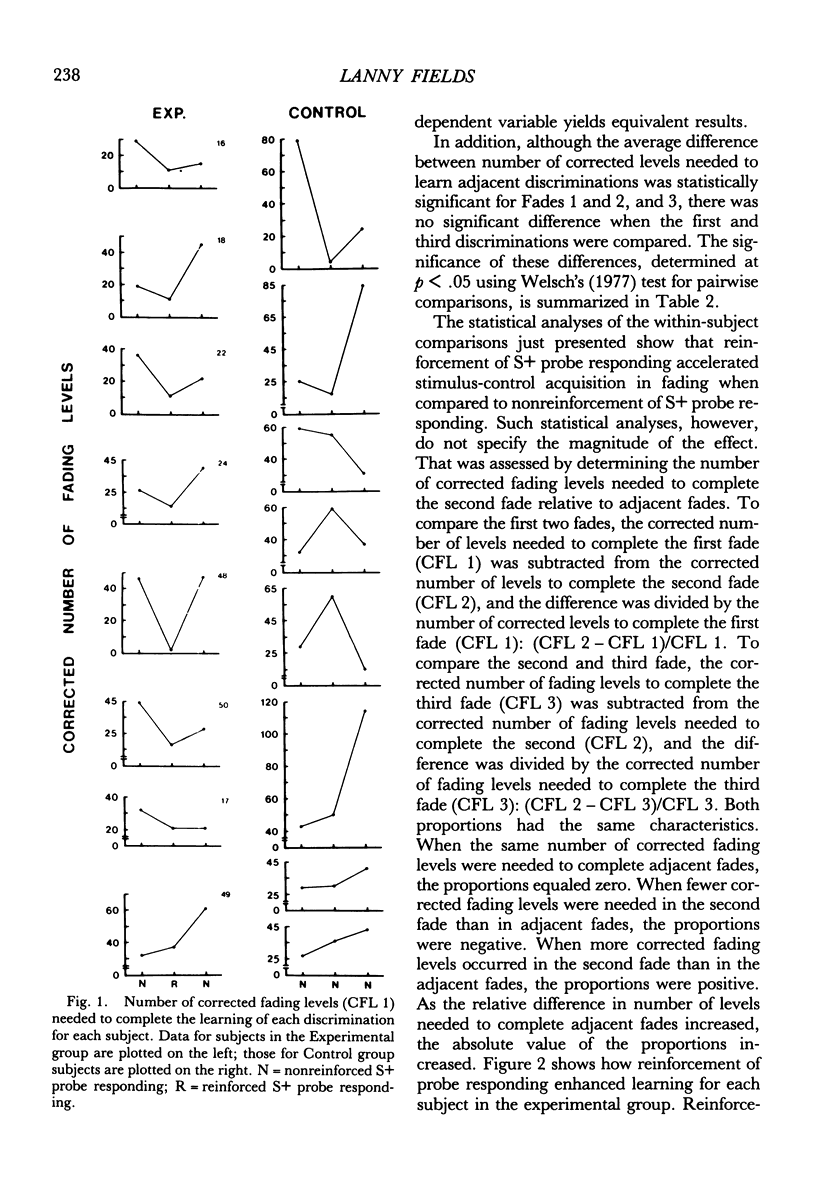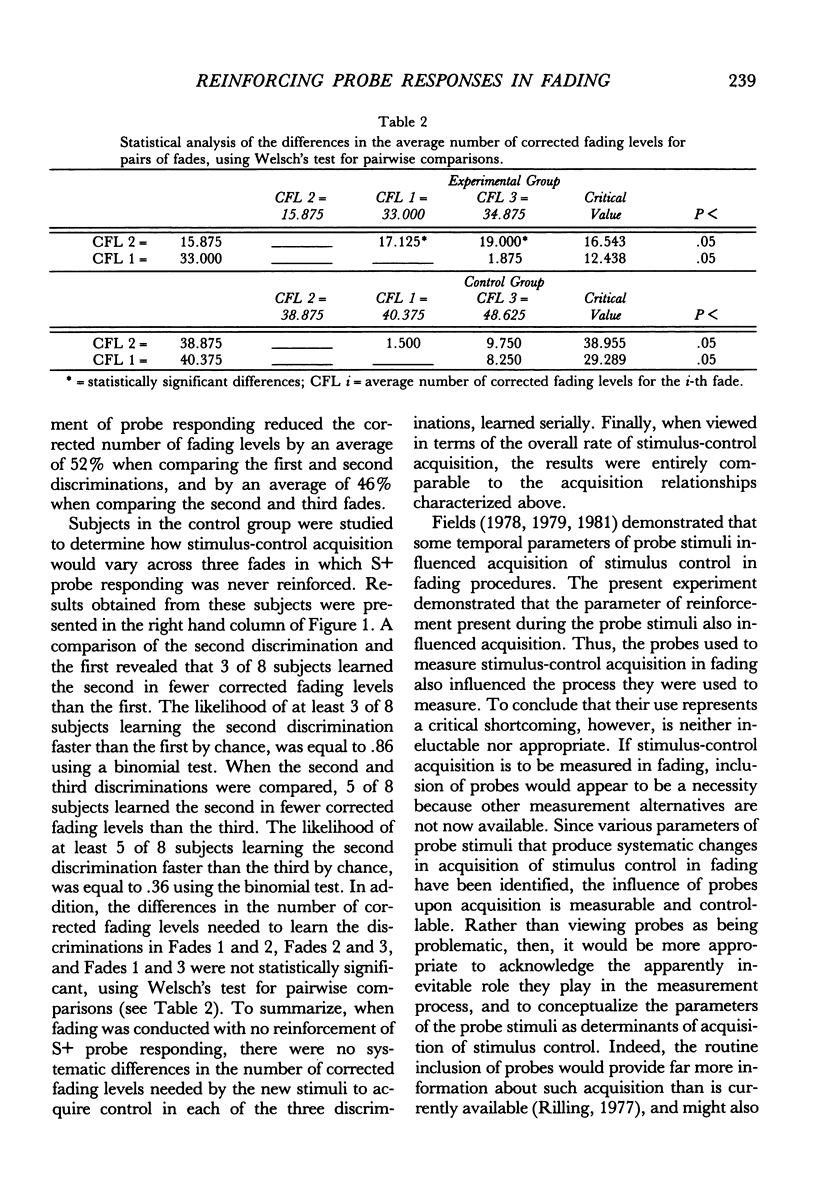Abstract
Stimulus control of pigeons' key pecking was transferred from colors to lines by the method of stimulus fading. Fading was conducted with the addition of probes consisting of the line stimuli presented alone at each fading level. Probe responding was used to measure stimulus-control acquisition by the lines. Effects of reinforcement and nonreinforcement of probe responding upon acquisition of stimulus control were assessed using a single-organism repeated-acquisition design in which three fades were conducted serially. Probe responding was not reinforced in the first and third fade but was in the second. Reinforcement of probe responding substantially reduced the number of fading levels needed to complete fading. The outcome of a control experiment ruled out the possibility of accounting for these results in terms of the specific stimuli used in each fade or in terms of the sequential exposure to the three discriminations. Although probes permitted measurement of stimulus-control acquisition in fading, a measurement/acquisition interaction was also present.
Keywords: stimulus fading, probe stimuli, measurement/acquisition interaction, repeated acquisition procedure, reinforcement of probe responding, discrimination learning, stimulus control transfer, key pecking, pigeons
Full text
PDF






Selected References
These references are in PubMed. This may not be the complete list of references from this article.
- Boren J. J., Devine D. D. The repeated acquisition of behavioral chains. J Exp Anal Behav. 1968 Nov;11(6):651–660. doi: 10.1901/jeab.1968.11-651. [DOI] [PMC free article] [PubMed] [Google Scholar]
- Brown P. L., Jenkins H. M. Auto-shaping of the pigeon's key-peck. J Exp Anal Behav. 1968 Jan;11(1):1–8. doi: 10.1901/jeab.1968.11-1. [DOI] [PMC free article] [PubMed] [Google Scholar]
- Doran J., Holland J. G. Control by stimulus features during fading. J Exp Anal Behav. 1979 Mar;31(2):177–187. doi: 10.1901/jeab.1979.31-177. [DOI] [PMC free article] [PubMed] [Google Scholar]
- Fields L. Acquisition of stimulus control while introducing new stimuli in fading. J Exp Anal Behav. 1979 Jul;32(1):121–127. doi: 10.1901/jeab.1979.32-121. [DOI] [PMC free article] [PubMed] [Google Scholar]
- Fields L., Bruno V., Keller K. The stages of acquisition in stimulus fading. J Exp Anal Behav. 1976 Sep;26(2):295–300. doi: 10.1901/jeab.1976.26-295. [DOI] [PMC free article] [PubMed] [Google Scholar]
- Fields L. Early and late introduction of probes and stimulus control acquisition in fading. J Exp Anal Behav. 1981 Nov;36(3):363–370. doi: 10.1901/jeab.1981.36-363. [DOI] [PMC free article] [PubMed] [Google Scholar]
- Fields L. Fading and errorless transfer in successive discriminations. J Exp Anal Behav. 1978 Jul;30(1):123–128. doi: 10.1901/jeab.1978.30-123. [DOI] [PMC free article] [PubMed] [Google Scholar]
- Huguenin N. H., Touchette P. E. Visual attention in retarded adults: combining stimuli which control incompatible behavior. J Exp Anal Behav. 1980 Jan;33(1):77–86. doi: 10.1901/jeab.1980.33-77. [DOI] [PMC free article] [PubMed] [Google Scholar]
- Karpicke J., Hearst E. Inhibitory control and errorless discrimination learning. J Exp Anal Behav. 1975 Mar;23(2):159–166. doi: 10.1901/jeab.1975.23-159. [DOI] [PMC free article] [PubMed] [Google Scholar]
- Lazar R. Extending sequence-class membership with matching to sample. J Exp Anal Behav. 1977 Mar;27(2):381–392. doi: 10.1901/jeab.1977.27-381. [DOI] [PMC free article] [PubMed] [Google Scholar]
- MOORE R., GOLDIAMOND I. ERRORLESS ESTABLISHMENT OF VISUAL DISCRIMINATION USING FADING PROCEDURES. J Exp Anal Behav. 1964 May;7:269–272. doi: 10.1901/jeab.1964.7-269. [DOI] [PMC free article] [PubMed] [Google Scholar]
- Schusterman R. J. Attention shift and errorless reversal learning by the California sea lion. Science. 1967 May 12;156(3776):833–835. doi: 10.1126/science.156.3776.833. [DOI] [PubMed] [Google Scholar]
- Sidman M., Stoddard L. T. The effectiveness of fading in programming a simultaneous form discrimination for retarded children. J Exp Anal Behav. 1967 Jan;10(1):3–15. doi: 10.1901/jeab.1967.10-3. [DOI] [PMC free article] [PubMed] [Google Scholar]
- TERRACE H. S. Errorless transfer of a discrimination across two continua. J Exp Anal Behav. 1963 Apr;6:223–232. doi: 10.1901/jeab.1963.6-223. [DOI] [PMC free article] [PubMed] [Google Scholar]
- Touchette P. E. Transfer of stimulus control: measuring the moment of transfer. J Exp Anal Behav. 1971 May;15(3):347–354. doi: 10.1901/jeab.1971.15-347. [DOI] [PMC free article] [PubMed] [Google Scholar]


